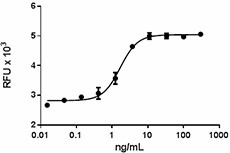- Regulatory Status
- RUO
- Other Names
- TNFSF14, tumor necrosis factor (TNF) superfamily member 14, Herpesvirus entry mediator ligand (HVEML), CD258.

-

Recombinant human Light induces proliferation of HUVEC in a dose dependent manner with ED50 = 1.5 - 6 ng/mL.
| Cat # | Size | Price | Quantity Check Availability | ||
|---|---|---|---|---|---|
| 762402 | 10 µg | $147.00 | |||
| 762404 | 25 µg | $253.00 | |||
Select size of product is eligible for a 40% discount! Promotion valid until December 31, 2024. Exclusions apply. To view full promotion terms and conditions or to contact your local BioLegend representative to receive a quote, visit our webpage.
LIGHT is a member of the TNF family which includes TNF-α, TNF-β (lymphotoxin-alpha, LT-α), CD40 ligand, TRAIL (Apo2L), Fas ligand (FASL), and osteoprotegerin (OPG) ligand. LIGHT is a type II transmembrane protein that possesses 34% identity with lymphotoxin beta (LT-β), and shares a 31% identity with FASL. LIGHT stimulates the proliferation of activated HVEM+ T-cells, NF-κB activation, and induces apoptosis in cells expressing both HVEM+ and LT-β receptors. B- and T- lymphocyte attenuators (BTLA) also bind to HVEM. LIGHT, as well as other members of the TNF/TNFR family, is released from the membrane by MMPs. It plays a key role for optimal IL-12 production by the dendritic cells (DCs) and the development of IFN-γ-producing CD4+ Th1 cells. Bone marrow-derived DCs from LIGHT (-/-) mice are severely impaired in IL-12p40 production after IFN-γ and LPS stimulation in vitro. LIGHT is expressed in lung inflammatory leukocytes after an allergen house dust mite challenge. It induces airway remodeling via the induction of TGF-β. The inhibition of LIGHT, using a fusion protein of Fc with the extracellular portion of the LT-β receptor (LTβ R-Fc), prevents LIGHT-LTβ R and LIGHT-HVEM interaction. In a mouse model of chronic asthma, this reduces lung fibrosis, smooth muscle and epithelial hyperplasia, and airway hyper-responsiveness through the suppression of lung TGF-β and IL-13 production. LIGHT has been shown to increase the anti-tumor immune response and its overexpression is associated with the survival in patients with colorectal cancer liver metastasis.
Product Details
- Source
- Human Light, amino acids (Asp74-Val240) (Accession# O43557), with N-terminal His tag was expressed in 293E cells.
- Molecular Mass
- The 188 amino acid recombinant protein has a predicted molecular mass of approximately 20.4 kD. The protein migrates at approximately 26 kD in both DTT-reducing conditions and non-reducing conditions by SDS-PAGE. The predicted N-terminal amino acid is His.
- Purity
- >95%, as determined by Coomassie stained SDS-PAGE.
- Formulation
- 0.22 µm filtered protein solution in PBS, pH 7.2.
- Endotoxin Level
- Less than 1.0 EU per µg protein as determined by the LAL method.
- Concentration
- 10-25 µg sizes are bottled at 100 µg/mL.
- Storage & Handling
- Unopened vial can be stored between 2°C and 8°C for up to 2 weeks, at -20°C for up to six months, or at -70°C or colder until the expiration date. For maximum results, quick spin vial prior to opening. The protein can be aliquoted and stored at -20°C or colder. Stock solutions can also be prepared at 50 - 100 µg/mL in appropriate sterile buffer, carrier protein such as 0.2 - 1% BSA or HSA can be added when preparing the stock solution. Aliquots can be stored between 2°C and 8°C for up to one week and stored at -20°C or colder for up to 3 months. Avoid repeated freeze/thaw cycles.
- Activity
- ED50 = 1.5 - 6 ng/mL, as measured by the ability of the protein to induce proliferation of HUVEC.
- Application
-
Bioassay
- Application Notes
-
BioLegend carrier-free recombinant proteins provided in liquid format are shipped on blue-ice. Our comparison testing data indicates that when handled and stored as recommended, the liquid format has equal or better stability and shelf-life compared to commercially available lyophilized proteins after reconstitution. Our liquid proteins are verified in-house to maintain activity after shipping on blue ice and are backed by our 100% satisfaction guarantee. If you have any concerns, contact us at tech@biolegend.com.
Antigen Details
- Structure
- Homotrimer.
- Distribution
-
Intestinal mucose T and NK cells, gut-homing CD4+ T cells, B cells, CD4 and CD8 lymphocytes.
- Function
- Enhances inflammation and T cell-mediated immunity, stimulates the proliferation of activated T cells. Homologous to lymphotoxins, it exhibits inducible expression and competes with HSV glycoprotein D for HVEM, which is a receptor expressed by T lymphocytes.
- Interaction
- T cells, B cells, NK cells, eosinophils, macrophages, and bronchial epithelial cells.
- Ligand/Receptor
- TNFRSF14/HVEM and LTβR, decoy receptor DCr3/TR6.
- Bioactivity
- Measured by its ability to induce proliferation of HUVEC.
- Biology Area
- Cell Biology, Immunology
- Molecular Family
- CD Molecules, Cytokines/Chemokines, Growth Factors
- Antigen References
-
1. Harrop JA, et al. 1998. J. Biol. Chem. 273:27548.
2. Wan X, et al. 2002. J. Immunol. 169:6813.
3. Xu G, et al. 2007. J. Immunol. 179:6901.
4. Doherty TA, et al. 2011. Nat. Med. 17:596.
5. Qin JZ, et al. 2013. J. Transl. Med. 11:70.
6. Qiu HN, et al. 2014. Mediators Inflamm. 2014:136463. - Gene ID
- 8740 View all products for this Gene ID
- UniProt
- View information about Light on UniProt.org
